This is the website of Abulsme Noibatno Itramne (also known as Sam Minter).
Posts here are rare these days. For current stuff, follow me on Mastodon
|
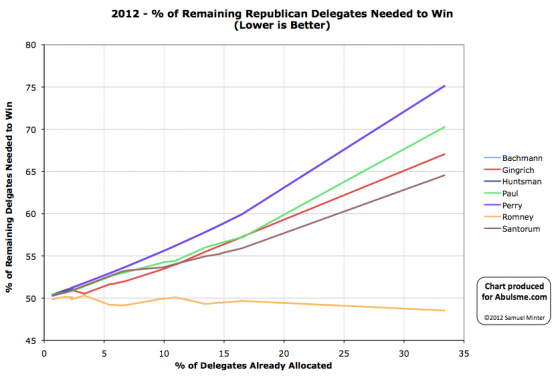
Chart from the Abulsme.com 2012 Republican Delegate Count Graphs page. When a candidate gets down to 0%, they have cinched the nomination. If they get up past 100%, they have been mathematically eliminated. Rather than the date on the x-axis, we show the “% of Delegates Already Allocated” as this better represents the progress through the race. Note that these numbers include estimates of the eventual results of multi-stage caucus processes which will be refined as the later stages occur.
So, Super Tuesday happened. As of this update, Green Papers has “called” 385 of the 419 delegates available from the Super Tuesday contests. There are 34 delegates that haven’t been determined yet that will result in updates later, but of the ones we do know, the estimates for Super Tuesday contests are: Romney 208, Santorum 84, Gingrich 72, Paul 21. Romney also picked up a Superdelegate, bringing the total for the day to Romney 209, Santorum 84, Gingrich 72, Paul 21.
Compared to the Sabato Crystal Ball projections which we used to game out Super Tuesday over the weekend, Romney performed better than expectations, as did Gingrich. Santorum and Paul underperformed compared to those predictions. In any case, where does this put us…
Bottom line, Romney is the big winner today, and this may be the start of him actually pulling away and heading toward the nomination, but he is still not out of the woods in terms of the danger of being blocked from 1144. Lets look at the details.
The situation for Santorum, Gingrich and Paul is essentially what I mapped out in the gaming Super Tuesday post. To paraphrase what I said there, it is now absolutely undeniably clear (although the trend was obvious even before today) that none of these three guys are on a path to the nomination. Of the three, Santorum is doing the best, but with today’s numbers, to be on a path to win, he would need to now get 64.5% of the remaining delegates, compared to the 21.1% he has gotten so far. For this to even come into the realm of possibility, Gingrich and Paul would both have to stop getting delegates, Santorum would have to pick up all of their support, AND something would need to happen to cause support for Romney to plummet. This is a very unlikely sequence of events. It isn’t going to happen.
Oh, I guess I should also note that Gingrich pulled back ahead of Paul for 3rd place.
The remaining question is: “Are the non-Romney’s collectively still in a position to potentially block Romney from getting to 1144?” If after today, Romney was under 50% of the total delegates, and his “% of remaining needed to win” was heading upward or flat, this is a possibility that would be looking like it was still very much in play. But Romney exceeded the 49.7% of delegates he needed in order to be on track toward 1144, and did it by a decent margin. Of the delegates in today’s total, he picked up 209 of 386, or 54.1%. This reduced his “% of remaining needed to win” from 49.7% to 48.5%. That means to block, the non-Romney’s collectively need to be getting 51.5% of the delegates, compared to the 46.9% they have managed so far. So they have to do better than they have been so far, and by a non-trivial margin. And they have do do this even though it is obvious none of them can win outright. It has to be about stopping Romney.
Now, the rest of March has a bunch of states that are supposed to be relatively good for the non-Romneys. So the non-Romney’s managing to get 51.5% in the next few state is very much within the realm of possibility. After that we hit more Romney friendly states in April. The thing to watch for in the upcoming states is not who wins the popular vote, or even the delegate count. The question will be: “Is Romney continuing to get enough delegates to avoid being blocked?” Right now, that magic number is 48.2%. As long as he is getting 48.2% of the delegates (or more) then he is marching his way toward the nomination. If he gets less than that, then blocking will remain possible a little bit longer. If the rest of March really is friendly to the non-Romneys, we may see that Romney’s “% needed to win” starts heading back up a bit before Romney hits friendly states again and starts fully pulling away. As long as we see that happening, blocking Romney is still a possibility. And indeed, if Romney is damaged by the contests in March and his April states start looking not so good after all, then blocking starts looking more real again.
But Romney’s “% of remaining needed to win” is the smallest it has been so far, and none of the other candidates have realistic shots at winning, only a shot at blocking that relies on them continuing to win delegates even though it is obvious they can’t win, so Romney is in a pretty good position right now. Watch that line though. Until it starts heading downward decisively, Romney hasn’t got it wrapped up just yet.
So what is next? Well, first, the last 34 delegates from Super Tuesday (they are from Georgia, Ohio and Tennessee). Then on Sunday we have Kansas (40), Guam (9), Northern Marianas (9), Virgin Islands (9). Then Tuesday we have Alabama (50), Mississippi (40), Hawaii (20), American Samoa (9). And then it goes on and on…

Chart from the Abulsme.com 2012 Republican Delegate Count Graphs page. When a candidate gets down to 0%, they have cinched the nomination. If they get up past 100%, they have been mathematically eliminated. Note that these numbers include estimates of the eventual results of multi-stage caucus processes which will be refined as the later stages occur.
The delegate count estimate in Maine is apparently a little jittery. On February 12th I posted the initial results as Paul 8, Romney 8, Santorum 4, Gingrich 1. On February 18th Green Papers updates this to Romney 8, Paul 7, Santorum 4, Gingrich 2. Today this seems to have gotten updated back to Paul 8, Romney 8, Santorum 4, Gingrich 1. So this means for the day Paul gains a delegate and Gingrich loses a delegate. At this point though, one delegate alone doesn’t make a significant difference in the overall picture.
According to our Soft Green Papers plus DCW Superdelegate count though, this means Ron Paul actually pulls ahead of Newt Gingrich into 3rd place in the delegate count by a two delegate margin. So I guess there is that.
There are a lot of states voting on Super Tuesday (10). Polling is sparse. The delegate rules vary greatly between states and are complicated. I don’t really have the resources or time to do a deep dive here. Luckily, other people do. On March 1st Sabato’s Crystal ball did a detailed delegate prediction while looking at all of those things. (They also included Washington, and it seems they probably overestimated Santorum there, but that’s how predictions go.) They don’t provide a range of predictions, just one. Their best guess, on Super Tuesday: Romney 197, Santorum 144, Gingrich 46, Paul 26.
This would bring their totals for the race to: Romney 393, Santorum 221, Gingrich 98, Paul 78. (This from adding Sabato’s numbers to my current estimates which combine the Soft Green Papers count and the DCW super delegate count.) Lets see where we would end up on my “% of remaining delegates needed to win” chart if the above is indeed what happens…
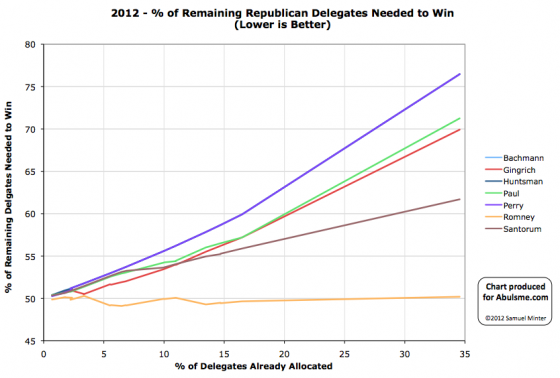
Now, technically speaking this is another of my “everybody loses!” results, as even Romney ends up increasing his “% or remaining delegates needed to win” number in this scenario (from 49.7% to 50.2%). But there are definitely degrees of losing, and Romney has by far the best deal here. Lets start at the bottom.
After this result Ron Paul would need 71.3% of the remaining delegates to catch up and win, compared to the 9.9% he would have gotten up to that point. This clearly is beyond what is reasonably possible. Paul was never about winning though, he is about getting his message out. So he’ll of course continue on.
After this result Newt Gingrich would need 69.9% of the remaining delegates to catch up and win, compared to the 12.4% he would have gotten up to that point. This is also clearly beyond the range of the reasonably possible. So the question becomes if Gingrich can continue to get funding anyway to stay in and continue acting as a spoiler, with the hope that along with the other non-Romneys he can block Romney from getting to 1144.
After this result Rick Santorum would need 61.7% of the remaining delegates to catch up and win, compared to the 28.0% he would have gotten up to that point. I am tempted to say this is ALSO clearly beyond the range of the reasonably possible, and I think it actually is. But for the sake of argument, you can imagine a situation where Gingrich and Paul both drop out (unlikely), Santorum picks up ALL of their support (unlikely) AND Romney has a series of major mistakes and his levels of support drop dramatically and significantly and those people decide they like Santorum after all (unlikely) then maybe Santorum can get to 61.7%. (If even more dramatically, on dropping out Gingrich instructed his delegates to vote for Santorum, and a bunch of them indicated they probably would, that would lower the 61.7% number, but still probably not enough.)
After this result Mitt Romney would need 50.2% of the remaining delegates to get to 1144 and seal the deal, compared to the 49.7% he had gotten so far. Unlike the other three candidates, these numbers are actually very close to each other. If he continues just that level, he gets blocked, but Romney only has to do SLIGHTLY better than he had been doing up to that point in order to actually win. At this point, Romney would NOT yet have started breaking out to drive his “% of remaining needed to win” number down toward zero. At the same time, he has not had a disaster where this number starts moving dramatically upward. But would these results put Romney in a position where finally pushing “% of remaining needed to win” down in the next few contests gets a lot easier?
If the actual result is anything like what Sabato and company predict for Super Tuesday, then it will be absolutely clear that Paul, Gingrich and Santorum are not on a path to win the nomination. (And frankly, even before Super Tuesday, this direction was clear, this would just hammer that home.) But the three of them will still collectively be in a position where if their ability to get delegates remains flat (or increases) they will block Romney. Their ability to keep this as something that remains possible (at least for awhile longer) will in large part depend on how Super Tuesday gets “spun”. If we start hearing from the talking heads about how Romney’s lead is now insurmountable and this is all over, then support for the other three will start to decline rapidly, and in the next contests Romney should be able to finally actually start closing in on a win and it really will be done.
If on the other hand, the spin is all about Romney still not closing the deal and that Santorum has momentum out of winning the popular vote in Ohio or some such regardless of the delegate situation, then this drags out a bit longer. But that depends on people continuing to vote for the non-Romneys, even after it is clear they have no shot at winning. It truly does become a “non-Romney” vote specifically aimed at blocking Romney rather than a vote actually for any of these three guys directly. But will the Santorum, Gingrich and Paul people actually do that? Or will they just say “I guess it is Romney” and either vote for Romney or just stay home, finally letting Romney start getting the margins of delegates he needs to wrap this thing up?
Given the overall situation, if pressed to make the prediction, I say the spin leans toward “Maybe Romney won the night on delegates… but look at all the shiny states won by the others… and Virginia doesn’t count because Santorum and Gingrich weren’t even on the ballot… Romney is having trouble closing the deal… we need to start looking at Kansas and Alabama and Hawaii and Mississippi and the rest of the states and territories in March (at least). And if this this and this happen, then… BROKERED CONVENTION! Wouldn’t that be AWESOME???”
I predict this not because I think the numbers actually back up this case, but because it is in the interests of the press to drag this out as long as possible, so they will hype any ray of hope the non-Romneys have for as long as they can possibly get away with it, which will in turn lead people to continue to think it is a contest and vote for the non-Romneys as the process continues to drag on, which will continue to feed the Romney hasn’t locked it up narrative for awhile longer. They did this in 2008 with the Democrats, they will do it in 2012 with the Republicans.
Then eventually it will get to the point where Romney’s lead is so overwhelming it will be hard to sustain that narrative, the support for the non-Romneys will finally start to dissipate, and Romney will slowly but surely make his way to 1144.
Having said that, despite my prediction to the contrary, I still hope the non-Romneys can sustain enough between them to block Romney. That would be much more fun to watch.
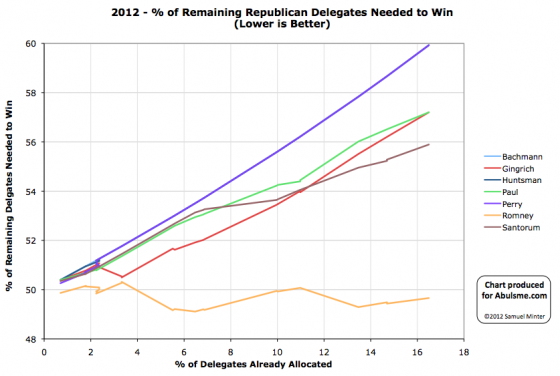
Chart from the Abulsme.com 2012 Republican Delegate Count Graphs page. When a candidate gets down to 0%, they have cinched the nomination. If they get up past 100%, they have been mathematically eliminated. Rather than the date on the x-axis, we show the “% of Delegates Already Allocated” as this better represents the progress through the race. Note that these numbers include estimates of the eventual results of multi-stage caucus processes which will be refined as the later stages occur.
So, today’s update includes the preliminary estimates from the Washington caucuses. As always, is important to note that no actual delegates were allocated at this point. That will happen at later stages of the process. Our graphs reflect Green Paper‘s “soft count” estimate, which will change over time as the later stages of the process happen. By those estimates, the results were Romney 16, Paul 10, Santorum 10, Gingrich 4. Santorum also picked up a super delegate since yesterday’s update. So for the day: Romney 16, Santorum 11, Paul 10, Gingrich 4.
Bottom line though, we have yet another day where EVERYBODY LOSES. Of course the narrative is all about how Romney has now “won” several in a row, and this gives him momentum going into Super Tuesday. And of course that is a very real effect. “Winning” and the media spin around it have a huge effect. People don’t just vote for their favorite candidate, they tend to want to vote for someone that can win. So things may change in future contests.
But as of right now, Romney did the best of the night, but he needed to get 49.4% of the delegates to be “on pace” to get to 1144. He actually got 16/41, or only 39.0%. So the percentage of remaining delegates he needs to get to win actually increases from 49.4% up to 49.7%. This isn’t a big move, but it is a move in the wrong direction. To be wrapping this up, Romney needs to be winning by numbers that drive this metric down. So far, he continues to hover in the range where if he continues as he has been, he will eventually win, but if he starts to do even slightly worse, he can be blocked.
For the non-Romneys, their path to the nomination continues to get more and more unlikely. Santorum is still in second place. He now needs 55.9% of the remaining delegates to catch up and win. This would be a remarkable change from the 20.4% of delegates he has managed so far. The more realistic goal for the non-Romneys at this point continues to be that they collectively get enough delegates to block Romney, not that any of them actually collect enough to win themselves. (Having said that, one of these guys catching up is not yet actually impossible if something major happens, it is just getting increasingly likely.)
I’ll also note that according to our estimates (combining the Soft Green Papers count and the DCW super delegate count) Ron Paul has now caught up and tied with Newt Gingrich for 3rd in the delegate count.
And now we have Super Tuesday. Although not as big as 2008, we’ll still have a large number of delegates awarded. The main thing to look out for: Does Romney’s “% of remaining needed to win” actually start to drop? If not, the possibility of him not getting to 1144 gets a lot more serious.
I am planning today to go to the Republican Caucuses here in Washington state. Doors open in about 30 minutes, you have to be signed in about 60 minutes from now, and 90 minutes from now the “action” should get started.
Assuming I am able to, I will be live tweeting as things progress. The tweets will appear on abulsme.com at a few minutes before 00:00 UTC in daily summary form, or you can follow me on Twitter to get updates in real time:
@abulsme
If I understand correctly, there will be a straw poll vote (which will be what is reported first by the press, but doest really matter), then there will be speeches and such, and then delegates will be picked for the county conventions. Those delegates will state their preferences most likely, but will not be bound in any way at the next level. Washington has 40 delegates, 30 will be winner take all 3 at a time by congressional district, and 10 will be proportional based on the state wide vote.
For the record, I plan on expressing my preferences (I hesitate to call what happens at a caucus actual voting) for Ron Paul. Of the four remaining Republican candidates, he is my preference by far. In terms of caucus participation, I am a Republican for the day, but at this point I am not ready to commit to what I will do in November. We shall see. And there will likely be other choices besides the Republican and Democrat, some of which may be interesting.
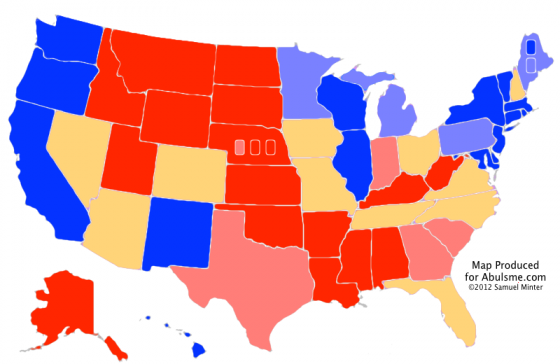
Map from the Abulsme.com 2012 Electoral College Prediction page. This map reflects Obama vs Romney. If any other candidate takes the lead in the Republican delegate race we’ll switch to making maps for them.
For a short time Romney’s last five poll average had dropped to less than a 10% lead in Montana, but the latest poll pushes that average back over 10%, so we color the state bright red again. Since either way Montana is not close to being a swing state (although the margin was only 2.3% in the 2008 election!) this does’t effect the overall summary of the race.
|
Romney |
Obama |
| Romney Best Case |
291 |
247 |
| Current Status |
210 |
328 |
| Obama Best Case |
159 |
379 |
This does represent the first state to move in Romney’s direction in a couple of weeks, which can be seen in our trend chart:
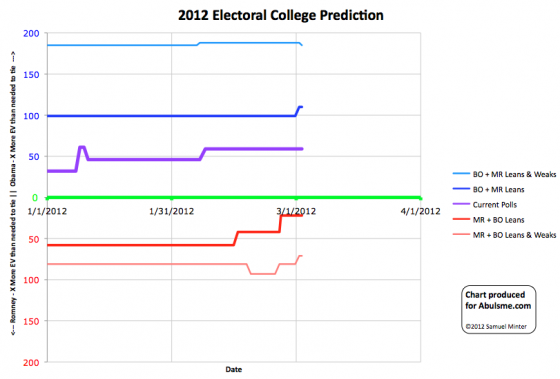
Chart from the Abulsme.com 2012 Electoral College Prediction page.
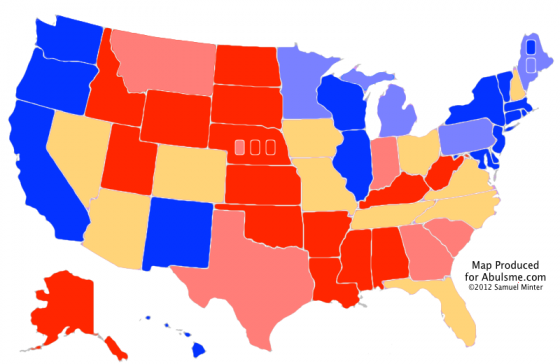
Map from the Abulsme.com 2012 Electoral College Prediction page. This map reflects Obama vs Romney. If any other candidate takes the lead in the Republican delegate race we’ll switch to making maps for them.
New polls in our last five poll averages move Obama’s lead in Wisconsin to over 10%, so that state moves into the “Strong Obama” category.
More interestingly perhaps, Romney’s lead in Tennessee drops to under 5%, moving that state to the “Lean Romney” category, which for purposes of our “best case” scenarios, puts the state into play for Obama. In 2008 McCain won Tennessee by a 15% margin, so this is somewhat surprising. We’ll see if this holds up as we move further into the year, but for the moment, that is where we are.
New Summary:
|
Romney |
Obama |
| Romney Best Case |
291 |
247 |
| Current Status |
210 |
328 |
| Obama Best Case |
159 |
379 |
And the trends since the beginning of the year…
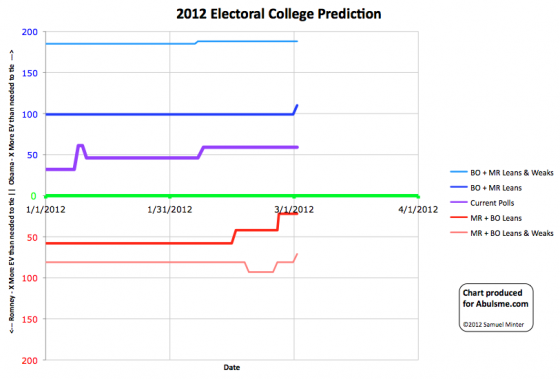
Chart from the Abulsme.com 2012 Electoral College Prediction page.
Up is better for Obama, so you can see that at least so far, things have generally been heading in his direction. It is of course still very early, so much will change between now and November.
Correction 2012 May 23 10:18 UTC: As it turns out, Wisconsin should NOT have flipped from Weak Obama to Strong Obama with this update on March 2nd. This change was influenced by the presence of a Washington State poll that I incorrectly included in my Wisconsin data. When this is backed out, Wisconsin does eventually go Strong Obama, but not until March 30th. Thanks to Darryl at HorsesAss for finding the error in my spreadsheet. The time series chart is corrected to reflect this starting with my May 23rd update.
Correction 2012 Jun 8 14:56 UTC: So, Tennessee shouldn’t have moved on this day either. The HorsesAss data included an old Tennessee poll from October 2011, that shows a strong Romney lead. The presence of this poll would have delayed the Tennessee move to “Lean Romney” until May 24th. This was noted and the historical graphs corrected starting with the June 8th update.
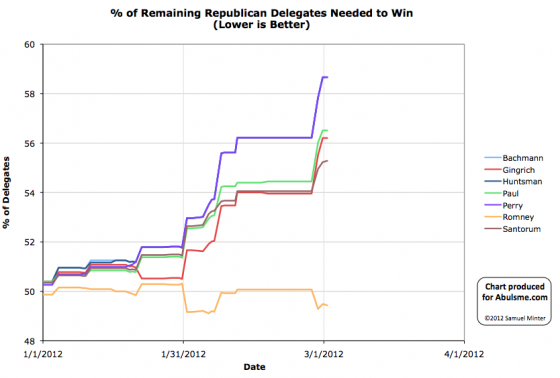
Chart from the Abulsme.com 2012 Republican Delegate Count Graphs page. When a candidate gets down to 0%, they have cinched the nomination. If they get up past 100%, they have been mathematically eliminated. Note that these numbers include estimates of the eventual results of multi-stage caucus processes which will be refined as the later stages occur.
So, everybody expected that 2 of Michigan’s delegates would be allocated proportionately, which meant that unless it was a complete blowout, you’d get one delegate each for the top two candidates statewide. But the Michigan GOP gave both delegates to Romney when they released the official results. They say that the proportional thing was a misunderstanding due to an error in an earlier memo and it was always going to be that way. The Santorum camp is calling shenanigans. More on this here and here. In any case, the result for the day is that Romney gains a delegate and Santorum loses one. It is just one delegate though, so the overall picture remains essentially the same.
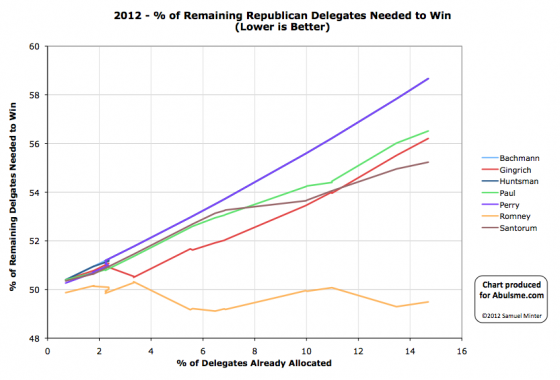
Chart from the Abulsme.com 2012 Republican Delegate Count Graphs page. When a candidate gets down to 0%, they have cinched the nomination. If they get up past 100%, they have been mathematically eliminated. Rather than the date on the x-axis, we show the “% of Delegates Already Allocated” as this better represents the progress through the race. Note that these numbers include estimates of the eventual results of multi-stage caucus processes which will be refined as the later stages occur.
So, first of all, that final congressional district in Michigan went for Santorum, so 2 more delegates for Santorum, making the final Michigan numbers 15 for Romney and 15 for Santorum, which was an exact match for my Scenario 2 in the post gaming out Arizona and Michigan.
Secondly, we have Wyoming. It is very important with Wyoming (as with similar caucuses previously) to point out that no national delegates were actually allocated in Wyoming yet. There was a straw poll, which doesn’t matter, and local delegates were selected for the next stage in the caucus process that will eventually select delegates to the national conventions. Ideally, each local delegate who was selected would be polled for their presidential preferences, and that would be used to predict results at the next level, etc. But that would be a ton of work, and nobody is doing that. Our source for these things, The Green Papers is doing the estimating by using the straw poll numbers for all candidates who got more than 5%. These estimates WILL change (perhaps significantly!) when the later caucus stages happen, but for now that is what we have. Green Papers estimates Wyoming as: Romney 10, Santorum 8, Paul 6, Gingrich 2.
And so when we pump this into the grinder and look at the “% of remaining needed to win” charts that I argue are the best way to see what is really happening… we find out… EVERYBODY LOSES. All four candidates in the race got delegates since my last update yesterday, but none of them got the delegates at the rate they would need to in order to get to 1144. Romney of course came closest. He got 10 out of 28 delegates today, or 35.7% of the delegates. But he needed to get 49.3% of the delegates (at least 14 of today’s 28) to actually be on pace to get to 1144.
Romney is still way ahead though. Right now he needs 49.5% of the remaining delegates to win. Santorum is in second needing 55.2% of the remaining delegates to win.
We are still fundamentally in a state where if Romney continues the way he has been, he will get to 1144, but very very late in the process… but with the possibility of the non-Romney’s blocking him still real. The non-Romney’s only have to do a little better than they have been to block Romney. One of the non-Romney’s actually catching up and winning gets to be an increasingly remote possibility as we move on though. Still not impossible. Just getting very hard. You would basically need consolidation around one non-Romney at the same time that Romney himself lost a significant amount of support.
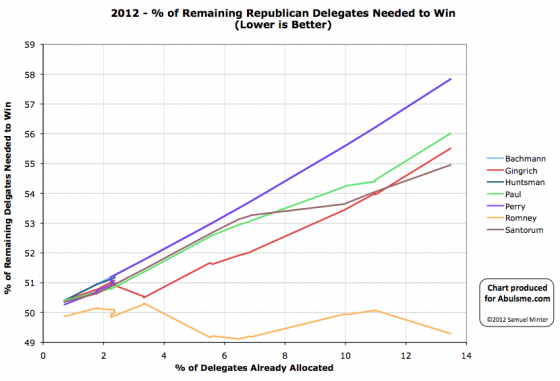
Chart from the Abulsme.com 2012 Republican Delegate Count Graphs page. When a candidate gets down to 0%, they have cinched the nomination. If they get up past 100%, they have been mathematically eliminated.
The chart above is now the chart using the “% of delegates already allocated” as the x-axis rather than the date, because I think it more clearly shows what is actually going on at this point.
Romney picks up all 29 delegates from Arizona. As of this update the best estimates at The Green Papers gives Romney 15 delegates from Michigan, Santorum 13, and 2 delegates still too close to call. Those of you who read my Gaming Out Arizona and Michigan post will recognize Scenario 2, which at the time I said was the most likely result, and indeed, that is what happened. If the last outstanding congressional district ends up going for Santorum, then it will actually match Scenario 2 exactly. Regardless though, the general outlines of Scenario 2 are met, and I’ll just quote my analysis from that earlier post:
Romney is still the only winner here. It is clearly not as big a win [as if he had won nearly all of Michigan’s delegates through a more geographically even win], but Romney still makes his “% of remaining delegates needed to win” go DOWN, and go down to under 50%. Santorum, despite getting some delegates, is still in a worse position than when he started the night. Before he needed 54.1% of the remaining delegates to catch up and win the nomination, now he needs 54.9% [actually 55.0% pending disposition of those last 2 delegates]. Santorum does pull ahead of Gingrich though, and put himself clearly into second place. But the three non-Romney’s in this situation are still all heading upward (toward being mathematically eliminated), none of them has started to actually move down toward catching up and winning. Romney in this situation does improve a bit here, but also still isn’t breaking out downward yet. He is still hovering in the zone where his opponents (collectively) only have to do a little bit better to block him from getting the nomination. Note that they do have to do better though. Paul, Gingrich and Santorum could keep getting delegates at the same rate, and Romney would still get the nomination, it would just take awhile.
Attention now moves to first Wyoming and Washington (although they are not getting much attention) and then of course Super Tuesday. Super Tuesday is not as super as it was in 2008, but there are still a big chunk of delegates at stake, and after it is over, we should have a better view of what the rest of the race looks like, and specifically if Romney is able to break out and start closing on 1144, or if the non-Romney’s still have a real shot at blocking him from getting there. (Let alone actually catching up and winning, which is a much further stretch.)
|
|










